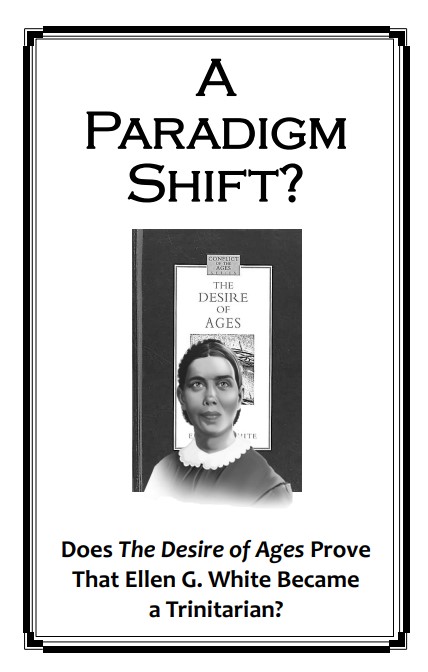The Personality of God and of Christ
It would be well to read the paper: "The Alpha and the Omega of Deadly Heresies in Seventh Day Adventism" before reading this one.
The Personality of God and of Christ
This presentation will set forth the personality of God and of Christ “which is everything to us as a people” Letter 300, 1903. The particular aspect of the personality of God and of Christ set forth in this study pertains to their Father-Son relationship as two individual personal Divine Beings, which relationship has been obscured through such teachings as the doctrine of the trinity and tritheism. And before continuing, if any readers are in doubt as to this momentous truth being a foundation pillar of our faith, let them consider the following statement:
"Those who seek to remove the old landmarks are not holding fast; they are not remembering how they have received and heard. Those who try to bring in theories that would remove the pillars of our faith concerning the sanctuary or concerning the personality of God or of Christ, are working as blind men. They are seeking to bring in uncertainties and to set the people of God adrift without an anchor." E.G. White, MR760 9.5
Thus, as Seventh Day Adventists, we can see a necessity on our part of understanding the personality of God and of Christ. To begin, we look back to the time when this pillar of our faith was re-established to Ellen Harmon and the early pioneers. From 1Biography we read:
"The spiritualization of heaven, God, Christ, and the coming of Christ lay at the foundation of much of the fanatical teachings that 17-year-old Ellen Harmon was called upon by God to meet in those formative days. The visions firmly established the personality of God and Christ, the reality of heaven and the reward to the faithful, and the resurrection. This sound guidance saved the emerging church." 1BIO 81
It was necessary for God to re-establish this foundational truth due to the fanatical teachings so prevalent at that time that obscured the personality of God and of Christ. For example, a prevalent teaching at that time was that God was a formless, impersonal being, having neither body nor parts.
It would be well to read the previous presentation: “The Alpha and the Omega of Deadly Heresies in Seventh Day Adventism" before continuing with this paper. However, if you did read the previous paper you will remember that the doctrine of the trinity also denies the personality of God and of Christ. And worse than this fact is that the doctrine of the trinity has now replaced the true understanding of the personality of God and of Christ within the Seventh Day Adventist church. We saw this change by comparing the 1889 and 1981 statements of fundamental beliefs.
Despite the knowledge that some Seventh Day Adventists have of the acceptance of the doctrine of the trinity, there are those among them who say: “Well, I have nothing to fear, I do not believe in the Catholic definition of the trinity.”
But question them further on what they in fact do believe on the subject of the Godhead, and you will find the following testimony from them to be quite common: “I believe in God the Father, God the Son, and God the Holy Ghost: three divine Beings.” This belief is actually known as polytheism or more specifically, tritheism, and to all such Adventists who proclaim it is this question addressed: Is such a belief Biblical?
Before answering this question, consider the following point. Within the framework of eternal truth, there are many ways to present the same truth. Thus, the multi-faceted gems of truth shine with new brightness from each different angle that you are given to view them. To the author of this presentation, the personality of God and of Christ has been clearly revealed by comparing the doctrine of tritheism with what the Bible, Spirit of Prophecy, and pioneers say on this subject. Read now to see the personality of God and of Christ revealed as regards their literal Father/Son relationship as we make this comparison.
Starting with Gordon Jensen, a present day Seventh Day Adventist, we have this definition of the tritheist doctrine:
"A plan of salvation was encompassed in the covenant made by the Three Persons of the Godhead, who possessed the attributes of Deity equally. In order to eradicate sin and rebellion from the universe and to restore harmony and peace, one of the divine Beings accepted, and entered into, the role of the Father, another the role of the Son. The remaining divine Being, the Holy Spirit, was also to participate in effecting the plan of salvation. All of this took place before sin and rebellion transpired in heaven. By accepting the roles that the plan entailed, the divine Beings lost none of the powers of Deity. With regard to their eternal existence and other attributes, they were one and equal. But with regard to the plan of salvation, there was, in a sense, a submission on the part of the Son to the Father." Adventist Review, October 31, 1996, p.12, Gordon Jensen.
We first examine this part of what Mr. Jensen says:
… the Three Persons of the Godhead …one of the divine Beings accepted, and entered into, the role of the Father, another the role of the Son. The remaining divine Being, the Holy Spirit was also to participate in effecting the plan of salvation … With regard to their eternal existence and other attributes, they were one and equal...
Here Mr. Jensen defines his understanding of the word “Godhead.” Three Persons of the Godhead are three co-eternal and co-equal Divine Beings, that is, three Gods comprising the Godhead. This is certainly a novel definition of the word “Godhead” but it is not Biblical. And here is where many, many Seventh Day Adventists stumble today. They have been handed a tritheistic definition of this Bible term from their fathers through the acceptance of the Omega of deadly heresies by the church. They have not searched for themselves to see what the word really means.
Turning to the Bible, we see that the word “Godhead” is used only three times in the scriptures. The word “context” means the parts just before and after a word or passage that determines its meaning. By examining the context of the word “Godhead” as used in the first two of the Bible texts in which it is found, and here a little, there a little in scripture (see Isaiah 28:10) for the third text, it becomes plain that the word refers to only one Divine Being, God the Father, and not a plurality of three:
(a) “Forasmuch then as we are the offspring of God2316, we ought not to think that the Godhead2304 is like unto gold, or silver, or stone, graven by art and man's device.” Acts 17:29
(b) “Because that which may be known of God2316 is manifest in them; for God2316 hath shewed it unto them. For the invisible things of him from the creation of the world are clearly seen, being understood by the things that are made, even his eternal power and Godhead2305; so that they are without excuse:” Romans 1:19,20
(c) “For in him [Christ] dwelleth all the fullness of the Godhead2320 bodily.” Colossians 2:9
“To wit, that God2316 was in Christ, reconciling the world unto himself...” 2 Corinthians 5:19
“… but the Father that dwelleth in me, he doeth the works.” John 14:10
And an examination of the meaning of the word “Godhead” from Strong’s concordance shows that in each of the three passages in the Bible where the word is used, it can be traced back to its derivative, God2316. The word God2316 means “the supreme divinity” and is used in the New Testament almost every time in context and meaning to refer to one Divine Being, God the Father, and not a plurality of divine Beings. Therefore, the New Testament says in hundreds of places that the Father Himself is the supreme divinity or Being.
(a) Acts 17:29 Strong's Greek 2304. theios thi'-os from 2316; godlike (neuter as noun, divinity): - divine, godhead.
(b) Romans 1:20 Strong's Greek 2305. theiotes thi-ot'-ace from 2304; divinity (abstractly):--godhead.
(c) Colossians 2:9 Strong's Greek 2320. theotes theh-ot'-ace from 2316; divinity (abstractly):--godhead.
(d) Strong's Greek 2316. theos theh'-os of uncertain affinity; a deity, especially (with 3588) the supreme Divinity; figuratively, a magistrate; by Hebraism, very:--X exceeding, God, god(-ly, -ward).
We can also see the truth that God the Father is the Godhead from the following Bible texts:
(a) “But to us there is but one God , the Father, of whom are all things, and we in him; and one Lord Jesus Christ, by whom are all things, and we by him. 1Corinthians 8:6.
(b) “One God and Father of all, who is above all, and through all, and in you all. Ephesians 4:6.
(c) “But I would have you know, that the head of every man is Christ; and the head of the woman is the man; and the head of Christ is God.” 1Corinthians 11:3.
Note carefully in 1st Corinthians 8:6 and Ephesians 4:6 the Bible definition of one God. The one God is the Father. Thus is clearly shown from the scriptures that the one God is not three persons making up one God as the orthodox trinity would have us believe, nor is it the tritheist belief that there are three Divine Beings in the Godhead. The Biblical one God is the Father.
We next see from 1Corinthians 11:3 the Divine order. The head of every woman is the man; the head of every man is Christ; and the head of Christ is God the Father. Thus is shown plainly from this scripture that the Father is the Godhead.
We next focus on this part of Mr. Jensen’s statement:
"A plan of salvation was encompassed in the covenant made by the Three Persons of the Godhead."
In contrast with this statement, the consistent teaching of the Bible and Spirit of Prophecy tell us that the plan of salvation encompassed in the covenant was not made by three beings, but by two, the Father and his only begotten Son:
"In the councils of heaven, before the world was created, the Father and the Son covenanted together that if man proved disloyal to God, Christ, one with the Father, would take the place of the transgressor, and suffer the penalty of justice that must fall upon him." MS 145, 1897
"Christ the Word, the Only Begotten of God, was one with the eternal Father,--one in nature, in character, and in purpose,--the only being in all the universe that could enter into all the counsels and purposes of God." GC 493
Notice that she does not mention any third divine Being as being able to enter into all the counsels and purposes of God which we should certainly expect to read here if we are to believe in three co-equal and co-eternal divine Beings as Mr. Jensen maintains. Instead, we read that Christ, the only begotten of God, was the only being in all the universe that could enter into all the counsels and purposes of God. And from the Youth’s Instructor we read:
"But the Son of God, who was with the Father before the world was, took pity upon us in our lost condition, and offered to step in between us and the wrath of an offended God …God consented to give his only Son to die for lost man. The lovely Jesus laid aside his glory, and came into this dark world, and took upon himself our nature, to be wounded for our transgressions, to be bruised for our iniquities." YI, August 1, 1852
The above statement also shows that God had a Son before the earth had been created. Continuing:
"The Father could not abolish nor change one precept of his law to meet man in his fallen condition. But the Son of God, who had in unison with the Father created man, could make an atonement for man acceptable to God, by giving his life a sacrifice, and bearing the wrath of his Father." 1SP 50
And the following:
"Father and Son are pledged to fulfill the terms of the everlasting covenant." YI, June 14, 1900
Not much commentary necessary here. Again, two divine Beings only are mentioned as pledged to fulfill the everlasting covenant for our salvation.
And two divine beings only know the cost:
"No man, nor even the highest angel, can estimate the great cost; it is known only to the Father and the Son." The Bible Echo, October 28, 1895
Now we read confirmation of two divine Beings only involved in the covenant of our salvation from the scripture as it is contained in this Spirit of Prophecy quote:
"The relation between the Father and the Son, and the personality of both, are made plain in this scripture also: "Thus speaketh Jehovah of hosts, saying, Behold, the man whose name is the Branch: And He shall grow up out of His place; And He shall build the temple of Jehovah; . . . And He shall bear the glory, And shall sit and rule upon His throne; And He shall be a priest upon His throne; and the counsel of peace shall be between them both. Zechariah 6:12, 13, A.R.V." 8T 269
Note that we were told long ago in the book of Zechariah that the counsel of peace would be between them both, that is, the Father and His Son; not between the three of them as the tritheist doctrine states. And finally, this quote that is a further expansion of the previous statement:
"The great plan of redemption was laid before the foundation of the world. And Christ, our Substitute and Surety, did not stand alone in the wondrous undertaking of the ransom of man. In the plan to save a lost world, the counsel was between them both; the covenant of peace was between the Father and the Son. "For God so loved the world, that he gave his only-begotten Son, that whosoever believeth in him should not perish, but have everlasting life." The Majesty of heaven, the King of glory, would become a servant. The only-begotten Son, in whom the Father delighted, was given for the ransom of a fallen race." ST, December 23, 1897
And thus the testimony is abundant from these passages and from others not mentioned here that there are ONLY TWO divine Beings involved in the covenant of our salvation, not three. Despite this counsel, Mr. Jensen teaches the existence of three independent, co-equal and co-eternal Gods thus:
"Three Persons of the Godhead, who possessed the attributes of Deity equally ... the divine Beings lost none of the powers of Deity. With regard to their eternal existence and other attributes, they were one and equal"
Now give this statement some serious thought. If there are three co-equal and co-eternal Gods as Mr. Jensen affirms, then it follows that one could not possibly be a real Father nor could one possibly be a real begotten Son because they would ALL BE EQUAL and the SAME AGE. In harmony with this conclusion, the author assumes that:
"one of the divine Beings accepted, and entered into, the role of the Father, another the role of the Son."
Really! According to this statement, we see that one of the divine Beings is only playing the role of “Father” to “Son”. Yet another of the divine Beings is only playing the role of “Son” to the “Father.” In other words, in this teaching, the Father is not truly the Father of Jesus, nor is Jesus truly the Son of the Father. Instead, they are two co-equal and co-eternal Gods who are pretending and playing these roles! They are acting! Where is such doctrine to be found in the Bible, Spirit of Prophecy, or pioneers?
This version of the trinity, known as tritheism, denies that which makes God the Father as a Father indeed to his Son, and the Son of God as a literal Son (offspring) of his Father. Thus the personality of God and of Christ as a true Father-Son relationship is destroyed through this teaching.
Another recent Seventh Day Adventist writes along the same lines as Mr. Jensen thus:
"The Father–Son relationship in the Godhead should be understood in a metaphorical sense, not in a literal sense." Max Hatton, Understanding the Trinity, p. 97
This statement is also a direct denial of the personality of God and of Christ. Mr. Hatton denies the Father-Son relationship proclaimed by the Father and Son themselves found so abundantly in the Bible and Spirit of Prophecy as we will soon see. But first, to get a deeper sense of the implications of Mr. Hatton’s statement, let us contrast his statement with the following from the Spirit of Prophecy:
"When the world is at last brought up for trial before the great white throne, to account for its rejection of Jesus Christ, God's own messenger to our world, what a solemn scene it will be! What a reckoning will have to be made for nailing to the cross One who came to our world as a living epistle of the law. God will ask each one the question, What have you done with my only begotten Son? What will those answer who have refused to accept the truth…?" RH, January 30, 1900 par. 11
At that time, when A Holy God of absolute truth asks each person what they have done with His only begotten Son, will Mr. Hatton and all such persons who teach such a doctrine then understand the Father-Son relationship in a metaphorical sense?
Here now is a sample of the abundant testimony that God the Father is truly the Father of his dear Son and that Jesus Christ is truly the begotten Son of His Father. Included in this next quote is the Spirit of Prophecy definition of the personality of God and of Christ. It is very simple:
"The Scriptures clearly indicate the relation between God and Christ, and they bring to view as clearly the personality and individuality of each. [Hebrews 1:1-5 quoted] God is the Father of Christ; Christ is the Son of God" 8T 268
And also:
"There is a personal God, the Father; there is a personal Christ, the Son." RH, November 8, 1898
There you have it. The Father and His Son are two divine Beings that have a real Father and Son relationship indeed and are not part of a role playing trinity! And that Christ is not a created being or playing a role, but begotten of His Father, we read the following:
"A complete offering has been made; for "God so loved the world, that he gave his only-begotten Son,"-- not a son by CREATION, as were the angels, nor a son by ADOPTION, as is the forgiven sinner, but a Son BEGOTTEN in the express image of the Father's person, and in all the brightness of his majesty and glory, one equal with God in authority, dignity, and divine perfection. In him dwelt all the fullness of the Godhead bodily." ST, May 30, 1895
The first note to make after reading this passage is that there are Seventh Day Adventists today who affirm that the words created and begotten mean the same thing. Please note the difference that Mrs. White makes here in the use of the words creation and begotten. The angels are created beings and Sister White affirms in this paragraph that Christ is not a son by creation. She says that Christ is a Son begotten in the express image of the Father’s person, and in all the brightness of his majesty and glory. It should be plain here that the words created and begotten mean two different things in reference to Christ.
With this thought in mind, now think on the last half of the statement from Sister White:
"… but a Son begotten in the express image of the Father's person, and in all the brightness of his majesty and glory, one equal with God in authority, dignity, and divine perfection. In him dwelt all the fullness of the Godhead bodily." ST, May 30, 1895
The birth of Jesus Christ shown here must be a description of a divine birth, before his birth into humanity. How can we know this? Let us compare this part of the statement with others of Christ's birth into humanity:
He was born in a stable ... cradled in a manger. Luke 2:7.
His divinity was veiled with humanity DA 23 ... and was made in the likeness of men: Philippians 2:7.
His glory was veiled, that the majesty of His outward form might not become an object of attraction. DA 43
His greatness and majesty were hidden, That He might draw near to sorrowful, tempted men. DA 23
By being born of the seed of Abraham, Christ took fallen, sinful human flesh upon Himself. Therefore, the description of His birth into humanity as we just read could not, and in fact did not, include the words that He was begotten in the express image of the Father's person, and in all the brightness of his majesty and glory ... and divine perfection. These are descriptions showing two different events. One relates to His divine birth, and the other to His birth into humanity.
And this is not an isolated statement from the Signs of the Times proclaiming Jesus’ divine birth. We read the following testimony:
"The Eternal Father, the unchangeable one, gave his only begotten Son, tore from his bosom Him who was made in the express image of his person, and sent him down to earth to reveal how greatly he loved mankind." RH, July 9, 1895




